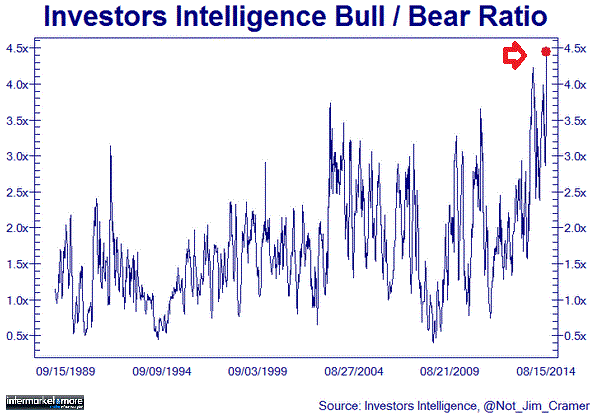in caricamento ...
La mandria impazzita dei tori imperversa sui mercati
 E’ solo statistica, ma è sempre carina segnalarvela soprattutto quando raggiunge picchi estremi all’ennesima potenza.
E’ solo statistica, ma è sempre carina segnalarvela soprattutto quando raggiunge picchi estremi all’ennesima potenza.
Torniamo a parlare di uno di quegli indicatori di sentiment più comuni ma anche più discussi, ovvero il Bull Bear Ratio che mette a confronto i rialzisti ed i ribassisti. Quando il market sentiment è eccessivamente ottimista (e non ci sono “orsi” sul mercato) allora l’indice Bull Bear Ratio spicca il volo. Viceversa quando c’è un eccesso di pessimismo.
Questo indicatore funziona bene soprattutto con logica “contrarian” soprattutto quando si toccano picchi estremi.
Bene, guardate in che condizioni si trova oggi il Bull Bear Ratio. Ok, gli stimoli monetari condizionano il mercato, però questi picchi,nella storia, non si sono mai visti…
Bull Bear Ratio
Sembra di trovarsi nelle strade di Pamplona con una mandria di tori impazziti… Gli orsi? Tutti in letargo. Quantomeno all’apparenza. Magari stanno aspettando che si quietino gli entusiasmi per poi prendere possesso della situazione… Molto dipenderà ovviamente dal margaro Draghi…
Se poi, sempre per statistica, vi volete divertire con questo grafico non troppo allegro…ma state sereni (come dice un mio vecchio amico di Firenze)…è solo statistica e alla fine non sono che 4 righe tirate a casaccio.
Nella fattispece Dow Jones e NYSE…. (ps: vi risparmio Gann…)
DOW JONES INDUSTRIAL AVERAGE & NYSE
e il Nasdaq Comp…ormai è ad un passo dai massimi storici…
STAY TUNED!







… ❝U.S. supply and demand shocks affect the German and the U.S. economy symmetrically and that supply shocks tend to have medium-term effects, while demand shocks impact on the economies in the short-run only.❞ …
… ❝International effects related to the U.S. monetary policy shock are most pronounced, while U.S. aggregate demand and supply shocks trigger more modest responses.
Second, the shape of the responses depends on the structural interpretation of the specific shock.
More specifically, while international responses to U.S. demand shocks are short-lived those to the remaining shocks are more permanent in nature.
Finally, U.S. shocks spread globally through interest rates, co-movements in output and indirectly via movements in the oil price.
These results are complemented by some systematic cross-regional differences that emerge from the analysis.❞ …
… ❝In general, Advanced Economies are strongly integrated with the global economy and among themselves. […] More specifically, foreign inflation, the oil price and – to a lesser extent – foreign output are the most important external factors in Advanced Economies that explain movements in real GDP, domestic inflation, the trade balance and interest rates.
In a similar fashion, these factors appear as important determinants of domestic variables in Asia.
However, movements in domestic Asian variables are also strongly influenced by foreign long-term interest rates.
For Emerging Europe, the SSVS prior reveals rather parsimonious models for the six equations in terms of both foreign and domestic factors.
Co-movements in foreign output are by far the most important determinant of real activity, while the oil price plays a more prominent role for domestic inflation and the trade balance.
Finally note the particular strong support for foreign interest rates in the equation for domestic long-term interest rates. This might be partially explained by the low coverage of domestic long-term interest rates in Emerging Europe.
Devoid of domestic longterm interest rates, foreign interest rates are likely to absorb variation that would otherwise be soaked up by domestic financial variables.
Lastly, in Latin America foreign price dynamics and the oil price are important determinants of most equations, while foreign output receives strong posterior support in the domestic output equation only.
Latin America is the only region, where exchange rates are explained solely by foreign prices, while no support for co-movements of exchange rates appears in the data.
Similar to economies in Emerging Europe, the coverage of domestic long-term interest rates is low which might explain the particularly strong role of foreign long-term interest rates in the respective domestic equation.
In general, these first cross-country differences suggest that shocks are transmitted differently across the regions.
They do not, however, yield insights about the extent to which a particular region is exposed to a foreign shock, which is analyzed by means of impulse response functions […].❞ …
… ❝A forecast error variance decomposition lends further support to the financial channel: U.S. interest rates appear systematically as important factor explaining forecast error variances related to domestic output, short-term interest rates and inflation.
This emphasizes the pivotal role of the U.S.A. in shaping global financial markets.❞ …
… ❝While have found evidence for spillovers via domestic interest rates in all regions, the responses in Latin America are particularly pronounced.
This might be explained by the fact that Latin American economies tend to peg their domestic currencies in one way or the other to the U.S. dollar.
Looking at the foreign factors that account for large shares of forecast error variance in domestic output, short-term interest rates and inflation, variables from leading industrialized economies and China appear frequently in the data.
Depending on the region under consideration, additional local specifics emerge.
As such, variables from the Euro-area resurface most frequently as determinants of forecast error variance in Emerging Europe, and U.S. related variables in Latin America respectively.
Also Korea and Indonesia explain significant shares of forecast error variance in Asia.
These determinants thus resemble international patterns in trade and financial flows.❞ …
₪回₪ M. Feldkircher, F. Huber (Oesterreichische Nationalbank), “The international transmission of U.S. structural shocks. Evidence from global vector autoregressions” – Working Papers 195: July 28, 2014
http://www.oenb.at/dms/oenb/Publikationen/Volkswirtschaft/Working-Papers/2014/Working-Paper-195/fullversion/WP195_screen/Working%20Paper%20195_screen.pdf
サーファー © Surfer